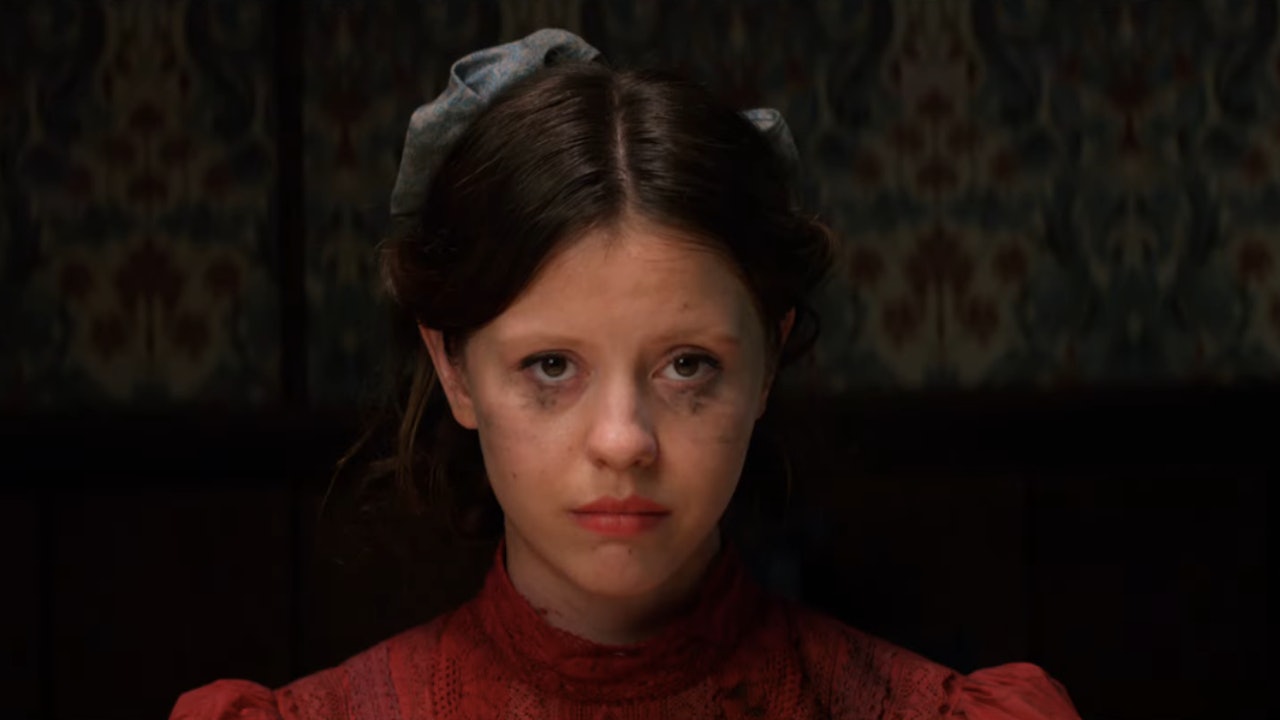
Horror sequels are nothing out of the ordinary. If a new movie manages to scare up a profit at the box office, you can pretty much assume a sequel is already in the works. Prequels, however, are another story. Even before George Lucas poisoned the well, it was generally agreed that trying to tell a new story set before the original was more trouble than its worth.
So it may come as a surprise that Pearl, the surprise prequel to Ti West’s surprise horror hit X, not only matches but exceeds the original. Filmed back-to-back with X before that movie earned $14 million on a budget of $1M, Pearl proves that A24’s first horror franchise is Mia Goth, who pulls double duty once again in a movie that manages to out-perform the original in nearly every way.
In X, Goth played both the final girl (aspiring porn star Maxine Minx) and the resentfully decrepit killer Pearl. In Pearl, Goth returns as the killer in her youth, but her second role as co-screenwriter proves even more important. Perhaps Goth’s touch is the secret sauce X sorely needed.
Pearl gets everything right where X gets so much wrong. Where the latter clumsily connects porn’s golden age to the 1970s independent film movement, the former states its own thesis clearly: movies are a wonderful escape from dreary reality, but they aren’t an excuse to disassociate from it. But fair is fair. Combined, both films make an argument for Goth as one of 2022’s most vital actors, or if not that then certainly the gutsiest. Placed side-by-side, though, there’s no contest. Pearl is a gem.
It’s 1918 and Pearl is in her 20s (or possibly her late teens). She lives on the farm where the events of X take place with her flinty German mother Ruth (Tandi Wright) and invalid father (Matthew Sunderland). Pearl goes about her daily chores with a blithe spirit. Farm life, she declares repeatedly, isn’t for her. She’s a movie star. She just needs a big shot working in the pictures to discover her. The callous joke West tells about Pearl in these films is that she isn’t a star at all, just a delusional naif with dreams outsized to her talent.
Plot plays little part in Pearl: The film revolves around Pearl’s confrontations with Ruth, chitchats with her sister-in-law Mitzi (Emma Jenkins-Purro), uncomfortable bathtimes with her dad, and occasional unauthorized jaunts to the town theater, run by a fine as wine fella referred to only as “the projectionist” (David Corenswet). As Pearl waits for her husband Howard’s return home from Europe, her patience with her parents, Mitzy, and even the projectionist grows deliriously thin. All her pent-up frustration and ego has to vent at some point. Pearl asks us to guess when, and on whom.

Instead of a propulsive thriller, Pearl functions as a character study with psycho underpinnings. West cedes the stage exclusively to Goth instead of asking her to share it with his ensemble as she does in X. Of all the smart choices Pearl makes, centering the narrative on Goth is the smartest. She exudes greater presence here playing just the one character than she does playing two in X, which says much given that she’s still the best thing about it.
But with only Pearl to consider (and with the spotlight trained on her) Goth digs into the character with what reads as zeal upfront but on closer inspection looks an awful lot like affection. Goth slowly slices Pearl open over the movie’s course, leading up to a third-act monologue clocking in at several minutes’ worth of confessional vulnerability. It’s the punctuation mark to the questions Pearl asks about what drives her and (more importantly) what in the hell is wrong with her.
Pearl cuts a sympathetic figure in X, where she’s characterized as the product of life’s disappointments. She washes her failure’s bitter taste from her mouth by slaying the young and the beautiful at their sexual peak. Pearl trades X’s sympathy for empathy. West and Goth keep intact the suggestion that fate dealt Pearl a bum hand, but the film paints a clear picture of what being American meant in the 1910s. Yes, Pearl had it hard, but so did everyone else. Her disappointments and hardships aren’t unique. Neither are her hopes and dreams. What sets Pearl apart from everyone else is that she won’t take “no” for an answer.

Goth acts as much through expression as expectoration. She flashes million-watt smiles, gambols about sets like a carefree otter, oozes a humble charm that belies Pearl’s hunger for fame and murderous rage, and treats phlegm, drool, and tears as props. Any actor willing to push themselves so far on camera that they start dripping snot tendrils is one worth paying attention to. Goth puts her soul, plus a whole box of Kleenex, into fully realizing Pearl from pastoral ingenue to axe-swinging maniac. No other performance on screen this year comes close to hers in terms of self-assured abandon.
Pearl’s credits linger on the image of her desperate, maniacal, fourth-wall-breaking grin, which she holds for the camera for so long one hopes she only needed a single take to nail it. Goth is so invested in Pearl’s well-roundedness, though, that if getting the take right meant straining her jaw, she probably would have, and her commitment echoes throughout the rest of the film’s production.
West grounds Pearl with that thought in mind. This is an artist with his eyes trained on the past. Movies like The Roost, The House of the Devil, and The Innkeepers each draw on specific horror niches (haunted house films, Satanic worship and supernatural films, and monster movies) as well as 1970s and 1980s aesthetics.
Pearl and X are both on-theme for West, then, but Pearl benefits immensely from streamlining. In X, West’s kitchen sink tendencies get the better of him. Instead of having an idea, he has all of them, which stirs up a discordance of theme, style, atmosphere, and character that sets the movie off-kilter. But Pearl lands right in the 1930s and stays there through the use of Technicolor visuals, wipe transitions, and iris shots. West’s facility with these techniques dovetails with Goth’s work for a shocking, foundational effect: the oldfangled sensibility evoked through Pearl’s design adds oomph to its every act of violence, be it small (pitchforking a duck) or great (pitchforking a person). Strictly speaking, X is gorier. In Pearl gore is used sparingly, but it hits harder against West’s backdrop — and so does Goth’s gradual ascent to madness.
Pearl debuts in theaters on Friday, September 16.







